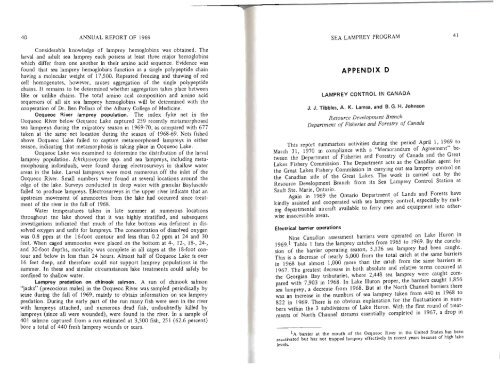Create successful ePaper yourself
Turn your PDF publications into a flip-book with our unique Google optimized e-Paper software.
40 ANNUAL REPORT OF <strong>1969</strong><br />
SEA LAMPREY PROGRAM<br />
41<br />
Considerable knowledge of lamprey hemoglobins was obtained. The<br />
larval and adult sea lamprey each possess at least three major hemoglobins<br />
which differ from one another in their amino acid sequence. Evidence was<br />
found that sea lamprey hemoglobins function as a single polypeptide chain<br />
having a molecular weight of 17,500. Repeated freezing and thawing of red<br />
cell homogenates, however, causes aggregation of the single polypeptide<br />
chains. It remains to be determined whether aggregation takes place between<br />
like or unlike chains. The total amino acid composition and amino acid<br />
sequences of all six sea lamprey hemoglobins will be determined with the<br />
cooperation of Dr. Ben Pollara of the Albany College of Medicine.<br />
Ocqueoc River lamprey population. The index fyke net in the<br />
Ocqueoc River below Ocqueoc Lake captured 259 recently metamorphosed<br />
sea lampreys during the migratory season in <strong>1969</strong>-70, as compared with 677<br />
taken at the same net location during the season of 1968-69. Nets fished<br />
above Ocqueoc Lake failed to capture metamorphosed lampreys in either<br />
season, indicating that metamorphosis is taking place in Ocqueoc Lake.<br />
Ocqueoc Lake was examined to determine the distribution of the larval<br />
lamprey population. Ichthyomyzon spp. and sea lampreys, including metamorphosing<br />
individuals, were found during electrosurveys in shallow water<br />
areas in the lake. Larval lampreys were most numerous off the inlet of the<br />
Ocqueoc River. Small numbers were found at several locations around the<br />
edge of the lake. Surveys conducted in deep water with granular Bayluscide<br />
failed to produce lampreys. Electrosurveys in the upper river indicate that an<br />
upstream movement of ammocetes from the lake had occurred since treatment<br />
of the river in the fall of 1968.<br />
Water temperatures taken in late summer at numerous locations<br />
throughout tne lake showed that it was higWy stratified, and subsequent<br />
investigations indicated that much of the lake bottom was deficient in dissolved<br />
oxygen and unfit for lampreys. The concentration of dissolved oxygen<br />
was 0.8 ppm at the 16-footcontour and less than 0.2 ppm at 24 and 30<br />
feet. When caged ammocetes were placed on the bottom at 4-, 12-, 18-, 24-,<br />
and 30-foot depths, mortality was complete in all cages at the 18-foot contour<br />
and below in less than 24 hours. Almost half of Ocqueoc Lake is over<br />
16 feet deep, and therefore could not support lamprey populations in the<br />
summer. In these and similar circumstances lake treatments could safely be<br />
confined to shallow water.<br />
Lamprey predation on chinook salmon. A run of chinook salmon<br />
"jacks" (preCOCious males) in the Ocqueoc River was sampled periodically by<br />
seine during the fall of <strong>1969</strong>, mainly to obtain information on sea lamprey<br />
predation. During the early part of the run many fish were seen in the river<br />
with lampreys attached, and numerous dead fish, undoubtedly killed by<br />
lampreys (since all were wounded), were found in the river. In a sample of<br />
401 salmon captured from a run estimated at 3,500 fish, 251 (62.6 percent)<br />
bore a total of 440 fresh lamprey wounds or scars.<br />
APPENDIX D<br />
LAMPREY CONTROL IN CANADA<br />
J. J. Tibbles, A. K. Lamsa, and B. G. H. Johnson<br />
Resource Development Branch<br />
Department of Fisheries and Forestry of Canada<br />
This report summarizes activities during the period April 1, <strong>1969</strong> to<br />
March 31, 1970 in compliance with a "Memorandum of Agreement" between<br />
the Department of Fisheries and Forestry of Canada and the <strong>Great</strong><br />
<strong>Lakes</strong> <strong>Fishery</strong> <strong>Commission</strong>. The Department acts as the Canadian agent for<br />
the <strong>Great</strong> <strong>Lakes</strong> <strong>Fishery</strong> <strong>Commission</strong> in carrying out sea lamprey control on<br />
the Canadian side of the <strong>Great</strong> <strong>Lakes</strong>. The work is carried out by the<br />
Resource Development Branch from its Sea Lamprey Control Station at<br />
Sault Ste. Marie, Ontario.<br />
Again in <strong>1969</strong> the Ontario Department of Lands and Forests have<br />
kindly assisted and cooperated with sea lamprey control, especially by making<br />
departmental aircraft available to ferry men and equipment into otherwise<br />
inaccessible areas.<br />
Electrical barrier operations<br />
Nine Canadian assessment barriers were operated on Lake Huron in<br />
<strong>1969</strong>.1 Table 1 lists the lamprey catches from 1965 to <strong>1969</strong>. By the conclusion<br />
of the barrier operating season, 5,126 sea lamprey had been caught.<br />
This is a decrease of nearly 6,000 from the total catch at the same barriers<br />
in 1968 but almost 1,000 more than the catch from the same barriers in<br />
1967. The greatest decrease in both absolute and relative terms occurred at<br />
the Georgian Bay tributaries, where 2,448 sea lamprey were caught compared<br />
with 7,903 in 1968. In Lake Huron proper, the barriers caught 1,856<br />
sea lamprey, a decrease from 1968. But at the North Channel barriers there<br />
was an increase in the numbt.rs of sea lamprey taken from 440 in 1968 to<br />
822 in <strong>1969</strong>. There is no obvious explanation for the fluctuations in numbers<br />
within the 3 subdivisions of Lake Huron. With the first round of treatments<br />
of North Channel streams essentially completed in 1967, a drop in<br />
1A barrier at the mouth of the Ocqueoc River in the United States has been<br />
reactivated but has not trapped lamprey effectively in recent years because of high lake<br />
levels.
















